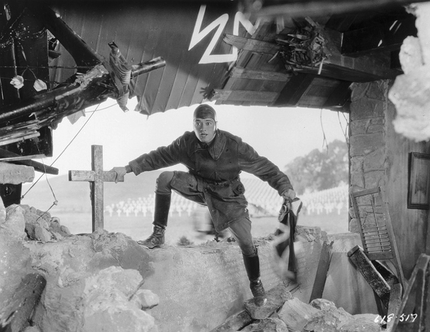Learning From The Masters Of Cinema: William A. Wellman's WINGS

Dubbed the last great silent film, William A. Wellman's 1927 action-packed epic is a simple story of friendship, love and rivalry set against the colossal backdrop of the First World War. Featuring some of the most incredible aerial battles ever committed to film, Wings remains a bona fide cinematic spectacle to this day, thanks in large part to a gorgeous new restoration.
Small town lad Jack (Charles "Buddy" Rogers) is infatuated with city girl Sylvia (Jobyna Ralston), unaware that she has pledged her devotion to his best friend, David (Richard Arlen), heir to the town's richest family. When war breaks out, both men enlist in the air corps, with Jack mistakenly believing Sylvia is in love with him. He also fails to realise that Mary (Clara Bow), the feisty girl-next-door is besotted with him. After their training, Jack and David are shipped off to France, where they are engaged in numerous deadly aerial battles with the Germans. Meanwhile, Mary becomes an ambulance driver and also heads overseas, where their paths are destined to cross again.
Wings was a production on an unprecedented scale, that cost Paramount Pictures a staggering $2 million - an unheard-of figure for a single film at that time. It was to be Paramount's roadshow title of 1927, toured around the country with a full orchestra, exhibited where possible in Magnascope. However, when John Monk Saunders pitched his story to the studio, they soon realised it would be a more expensive undertaking than even they had anticipated.
In a move that would, in the decades since, become standard Hollywood protocol for such a large, mainstream war picture, producer Lucien Hubbard approached the United States Military for support and equipment to use in the film. After a lot of red tape, and a request that went all the way up to the president himself, the project was green lit and given the full support of the United States Army and Air Force.
Production was stationed at Kelly Field, San Antonio, Texas, with thousands of military personnel employed as extras, as well as dozens of planes, tanks and other resources for recreating the film's many battle sequences. A number of large scale sets - including an entire French village that would be destroyed in the film - were constructed on and around the airbase. Estimates suggest that the US Military provided Paramount Pictures with around $15 million in equipment and support, a figure that in today's money, would make Wings easily the most expensive motion picture ever made.

Very much the Avatar or Gravity of its day, Wings was not only a large scale production, but also necessitated the development of technology and filming techniques that had never been used before. It is therefore somewhat surprising that Paramount hired such an unproven entity as 29-year-old William A. Wellman to direct the film. Before Wings, Wellman had only a fistful of B westerns to his name, and nothing that came close to approximating the scale or budget of this film. However, Wellman had served as a fighter pilot in the Great War, and it was this experience - coupled with his bullheaded countenance that convinced the studio to take a chance on "Wild Bill". While Wellman would go on to direct more than 80 features in a career spanning nearly four decades, including such acknowledged classics as The Public Enemy and The Ox-Bow Incident, nothing would ever again approach the scope of Wings.
Wellman's relationship with Paramount would prove tempestuous throughout the film's production - he was vehemently against the studio-imposed re-writes that inserted Clara Bow's character into the otherwise male-dominated film. Bow was a huge star at the time and Paramount were doing all they could to ensure their film had an audience when it premiered. Not that they need have worried. Wings was an immediate sensation, greeted by a nation entranced by air travel and the achievements of Charles Lindenbergh. While there had already been a few notable films to tackle the subject of World War I (which had ended less than a decade ago), none had captured aerial heroics like Wellman and his team of daredevil stunt pilots managed in Wings.
In large part, the aerial sequences proved so impressive because both Buddy Rogers and Richard Arlen are seen numerous times in close-up flying their own planes during the battles. While Arlen was already an accomplished pilot, Rogers took lessons before filming began, and despite being absolutely terrified, clocked up nearly 100 hours in the air, a feat that often saw him vomit the moment he set foot back on terra firma. Both actors would operate their own cameras, ensuring that they gave the best performances possible, and the results created an intimacy with the pilots, yet also a sense of palpable danger and spectacle, as the clouds and horizon spiral dizzyingly behind them.
Back on the ground, Wellman proved equally inventive with his camera. Numerous sequences in the film are tinted different colours to add mood to various scenes, while fire and explosions were also coloured onto the print for extra effect. A number of sequences see innovative camera movement - David and Sylvia on the swing, the dolly shot through the Paris dance hall - as the director pushed the boundaries of what the camera was able to do in order to create a more dynamic experience for his audience. This shone through as much in the film's soundtrack as in its visuals. Above and beyond the exhilarating J.S. Zamecnik score, Wings barely qualifies as a silent film due to Wellman's frequent use of sound effects, from gunfire and engine noises, to punches and explosions.
While the film's plot is simple and paints its themes of love, friendship, loyalty and tragedy in incredibly broad strokes, we remain invested in Wings' narrative, while it never distracts from the spectacle of the production. The futility of war is writ large by Wellman and Co, while the endless possibilities of cinema are brilliantly underscored by their envelope-pushing achievements, both on screen and behind the camera.
Masters of Cinema's new dual format Blu-ray/DVD release ports over all the special features from last year's US re-release, which prove incredibly educational and entertaining. There's an excellent retrospective documentary looking at the film's production as well as giving a wider picture of Hollywood in the 1920s. There's also a fascinating featurette about the extensive restoration work that Wings underwent, after it was feared lost for many decades. The disc also includes a short featurette on the evolution of planes used in warfare during WWI.
The first film ever to win Best Picture at the Academy Awards, and the only silent film to do so until Michel Hazanavicius' The Artist in 2011, Wings is both an incredible landmark in the technological evolution of the medium, but also a thrilling slice of action cinema that retains its ability to entertain and excite audiences 87 years after it was first screened. This new restoration has allowed the film to take flight and delight future generations of not only film historians and those curious about the early days of Hollywood, but anyone who enjoys and can appreciate the delights of escapist cinema. Wings is a soaring triumph.
Wings is available on dual format Blu-ray/DVD release in the UK from The Masters of Cinema now.

Do you feel this content is inappropriate or infringes upon your rights? Click here to report it, or see our DMCA policy.






